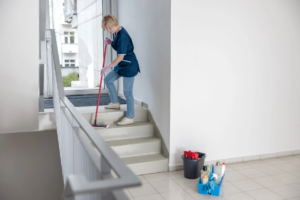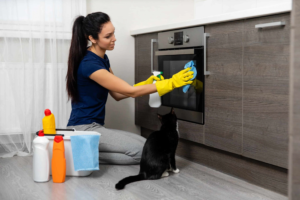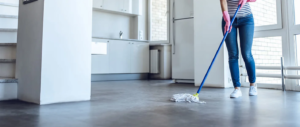[fsn_row][fsn_column width=”12″][fsn_text]
A home’s foundation, often hidden beneath layers of paint and years of accumulated dust, holds the key to a healthy living environment – the basement walls. Neglecting these vital surfaces can lead to a cascade of issues, from structural concerns to the growth of harmful molds. In this comprehensive guide, we will delve into the essential steps of maintaining a clean and pristine foundation through the lens of “How to Clean Basement Walls.” Join us on a journey to discover not only the intricacies of the cleaning process but also the significance of this often-overlooked aspect of home maintenance. Your basement’s well-being is not just beneath the surface; it’s at the core of a secure and comfortable home.
What is a Basement Wall?
A basement wall is more than just a structural element; it serves as the backbone of your home’s foundation, providing support and stability. Typically constructed from materials like concrete or brick, basement walls play a crucial role in safeguarding your living space. As the first line of defense against external elements, they bear the weight of the structure and shield your home from potential threats. Recognizing the significance of these walls is the first step in comprehending their vital role in maintaining a secure and healthy living environment.
Understanding the Importance of Clean Basement Walls
The importance of clean basement walls extends beyond mere aesthetics; it is a fundamental aspect of home maintenance that directly impacts your living environment. Regular house cleaning Langley, or any location, involves not only visible surfaces but also the often-neglected basement walls. Clean water, free from contaminants, is a prerequisite for a healthy home, and maintaining the cleanliness of basement walls contributes to this crucial aspect. Concrete walls, common in basements, can harbor dust, mold, and other pollutants, emphasizing the need for diligent cleaning. Additionally, controlling humidity levels is essential to prevent mold growth, and warm water, when used appropriately, becomes a powerful ally in combating dirt and stains. By understanding and prioritizing the cleanliness of basement walls, you not only enhance the aesthetic appeal of your space but also promote a safe and hygienic living environment.
Necessary Preparations Before Cleaning
Before diving into the cleaning process, it’s essential to gather the right tools and materials. Ensure proper ventilation and safety measures to create a conducive environment for effective cleaning. Check out other preparations you need to do below:
Gather Protective Gear
Before embarking on the journey of cleaning your basement walls, it’s crucial to gather the necessary protective gear. Equip yourself with rubber gloves to shield your hands from cleaning agents and potential irritants. Depending on the cleaning method, consider wearing additional protective gear, such as goggles or a mask, for added safety. When using tools like a pressure washer, proper footwear, and clothing that covers exposed skin are essential to prevent injuries. By prioritizing protective gear, you ensure a safe and secure environment as you tackle the task of rejuvenating your basement walls.
Read Product Labels Carefully
When venturing into the realm of basement wall cleaning, understanding the products you use is paramount. Carefully read and comprehend the labels on cleaning agents, ensuring they are suitable for the type of wall material you are dealing with. Some materials may react adversely to certain chemicals, emphasizing the need for informed choices. Whether you opt for a mild detergent, white vinegar, or a specialized water solution, being well-versed in the product’s instructions and limitations enhances the effectiveness of your cleaning process. This diligence not only guarantees optimal results but also safeguards your walls from potential damage caused by incompatible cleaning solutions.
Prepare the Area for Cleaning
Efficient cleaning begins with thorough preparation of the cleaning area. Remove any obstacles and clear clutter to facilitate easy access to the basement walls. For stubborn stains that require more than a scrub brush, a pressure washer can be a valuable tool, so ensure the surrounding area is appropriately protected. Cover electrical outlets and fixtures to prevent water damage, and lay down protective sheets to shield the floor. By taking these preparatory steps, you create a controlled and organized environment, setting the stage for a successful and hassle-free cleaning experience.
Assessing the Type of Wall Material
Before diving into the cleaning process, a crucial step is assessing the type of wall material in your basement. For many homes, especially older ones, concrete basement walls are common. Understanding the composition of your walls is vital, as different materials may require distinct cleaning approaches. Concrete stains can result from various sources, such as water infiltration or rust. Identifying the type of stain is essential for choosing the most effective cleaning method. For instance, a rust stain on a concrete foundation wall might require a different treatment than a water-based stain. This distinction is pivotal in achieving optimal results without causing harm to the structural integrity of the walls. Safety precautions should also be considered, especially when dealing with potentially abrasive or chemical cleaning agents, ensuring a thorough yet careful approach to rejuvenating your basement walls.
Step-by-Step Guide to Cleaning Basement Walls
Step 1: Remove Clutter and Obstacles
Commencing the journey to clean and revitalize your basement walls involves the crucial first step of clearing away clutter and obstacles. Remove any items or furnishings that might impede your access to the concrete walls. This ensures a seamless cleaning process and allows you to address every inch of the surface effectively. By creating a clear workspace, you pave the way for a thorough cleaning that reaches even the often-overlooked corners, setting the stage for a more pristine and welcoming basement.
Step 2: Dusting and Sweeping
Dusting and sweeping are the foundational steps in preparing your concrete walls for a deep clean. These actions eliminate loose dirt, cobwebs, and any surface debris that may have accumulated over time. Using a gentle brush or broom, carefully sweep away the initial layer of grime. This not only enhances the overall cleanliness of the walls but also primes the surface for more targeted cleaning in subsequent steps. Ensuring a dust-free and debris-free canvas is vital for the effectiveness of the upcoming cleaning solution, guaranteeing that the deeper layers of dirt and mold spores are addressed with precision.
Step 3: Preparing a Cleaning Solution
With clutter removed and surfaces dusted, the next step involves preparing a cleaning solution tailored to the needs of your concrete walls. Depending on the type of stains and contaminants present, the solution may vary. For a general clean, warm water and a mild detergent can be effective, providing a safe yet powerful mixture for removing common grime. In cases where mold spores have taken residence, incorporating an antifungal agent into the solution is advisable. The use of clean water in your mixture ensures that you are not introducing additional contaminants, promoting a cleaner and healthier environment. Taking the time to prepare the right cleaning solution is pivotal for achieving optimal results on your concrete surfaces.
Step 4: Scrubbing the Walls
Once the initial layers of dirt and debris have been cleared, the next step is to scrub the concrete surfaces thoroughly. Utilize a scrub brush or sponge to work the cleaning solution into the entire surface of the walls. Applying even pressure and using circular or back-and-forth motions helps dislodge embedded grime. For stubborn stains or areas with caked-on dirt, consider a more robust scrubbing technique. Rubber gloves are advisable to protect your hands during this process. Scrubbing is a pivotal step in rejuvenating your concrete walls, ensuring that the cleaning solution penetrates deeply and effectively removes contaminants.
Step 5: Addressing Stubborn Stains
Addressing stubborn stains requires a targeted approach. For tough stains on concrete surfaces, a more specialized cleaning solution may be necessary. In cases where mild detergent alone is insufficient, consider using a bleach solution for its powerful stain-removing properties. Apply the solution directly to the stubborn stains and let it sit for a few minutes before scrubbing again. Exercise caution when using bleach, and ensure proper ventilation. By tackling tough stains with precision, you ensure that your concrete walls emerge from the cleaning process looking revitalized and blemish-free.
Step 6: Rinsing and Drying
After the scrubbing process, the next crucial steps are rinsing and drying to complete the cleaning endeavor. Thoroughly rinse the entire surface of the concrete walls with clean water, removing any residue from the cleaning solution. This step is vital to prevent any lingering chemicals from affecting the integrity of the walls. Once rinsed, allow the walls to air dry completely. Adequate drying time is essential to prevent the growth of mold or mildew in any remaining damp areas. By completing this final stage, you ensure not only the cleanliness of your concrete surfaces but also their long-term health and durability.
Preventive Measures for Maintaining Clean Basement Walls
While a thorough cleaning is essential, proactive steps can be taken to prevent the recurrence of issues and maintain clean basement walls in the long run. Regularly inspect the walls for any signs of potential problems, such as cracks or water seepage, and address them promptly to thwart future mold growth. Implementing proper ventilation and air circulation in the basement helps control humidity levels, creating an environment less conducive to mold development. Additionally, store organic materials away from the basement, as they can be a potential food source for mold. By adopting these preventive measures, you not only preserve the cleanliness of your basement walls but also contribute to a consistently healthy living space.
Dealing with Common Basement Wall Issues
Understanding common basement wall issues is crucial for effective problem resolution. Here are some common basement wall issues:
Mold and Mildew
Mold and mildew, often found lurking on concrete basement walls, pose both aesthetic and health concerns. These unwelcome guests thrive in environments with excess moisture, making basements susceptible to their growth. When tackling mold and mildew, it’s essential to use cleaning solutions that effectively eliminate them without resorting to harsh chemicals that may pose a health risk. Identifying and addressing the source of excess moisture is key to preventing their return. Regular inspection and timely cleaning are crucial in maintaining clean and healthy concrete basement walls.
Efflorescence
Efflorescence, characterized by a white powdery substance on concrete surfaces, is a common issue indicating mineral deposits. It often occurs when water infiltrates the concrete and evaporates, leaving behind salt deposits. While efflorescence itself doesn’t pose a structural threat, it can be unsightly and indicative of water-related concerns. Addressing the root cause of water infiltration and cleaning the affected areas with gentle solutions are essential steps in managing efflorescence. Harsh chemicals should be avoided, as they can exacerbate the problem and potentially harm the integrity of the concrete basement walls.
Water Damage
Water damage in the basement is a serious issue that can compromise the structural integrity of concrete walls. It often manifests as discoloration, warping, or even cracks. Identifying and repairing the source of water intrusion is paramount to prevent further damage. Whether caused by leaks, flooding, or high humidity levels, excess moisture is a common denominator in water damage. Timely intervention and appropriate measures, such as improving drainage and waterproofing, are essential to safeguarding your concrete basement walls from the detrimental effects of water damage. Regular maintenance and vigilance can help mitigate the risks associated with water damage, preserving the longevity and health of your home.
Ensure pure flow! Wondering “how to clean water pipes in your house“? Click for expert tips and maintain clean, healthy pipes for a refreshing water experience!”
Tips for Maintaining a Dry Basement
Preserving a dry basement is essential for the health and longevity of your concrete basement walls. Adequate ventilation and air circulation play a pivotal role in preventing excess moisture, a common culprit behind various issues. Regularly inspect and address any potential sources of water infiltration, such as leaks or inadequate drainage. To combat mold growth and stains, utilize warm water as an effective and gentle cleaning agent for your concrete surfaces. In instances where stubborn stains persist, a carefully diluted bleach solution can be employed, but safety precautions must be observed. Prioritize wearing protective gear, such as gloves and goggles, to shield yourself from potential harm. By integrating these tips into your routine maintenance, you contribute to a consistently dry and healthy environment for your basement, ensuring the resilience and aesthetic appeal of your concrete basement walls.
Conclusion
Maintaining clean basement walls is a fundamental aspect of home care. By following the steps outlined in this comprehensive guide, you not only ensure a healthier living space but also contribute to the longevity and stability of your home. Regular cleaning and preventive measures are key to enjoying a dry, clean, and safe basement for years to come.
Transform your living space into a haven of pristine cleanliness with ProClean’s unparalleled house cleaning Maple Ridge services! Our dedicated team of experts is committed to delivering a meticulous cleaning experience tailored to your unique needs. Experience the joy of coming home to a spotless and refreshed environment – schedule your ProClean service today and elevate your living standards with unparalleled cleanliness and attention to detail!
FAQs: How to Clean Basement Walls
Can I use any cleaning solution on my basement walls?
It’s crucial to choose a cleaning solution based on the type of wall material. For concrete walls, a mixture of warm water and mild detergent is effective, while tougher stains may require a carefully diluted bleach solution.
Is it safe to use a pressure washer on basement walls?
While a pressure washer can be effective, it’s essential to use it cautiously. Maintain a safe distance, adjust the pressure, and ensure proper protective gear to prevent damage and ensure personal safety.
How can I prevent future mold growth on basement walls?
Regularly inspect and address sources of excess moisture, such as leaks or poor ventilation. Keeping the environment dry and using preventive measures like mold-resistant paint can significantly reduce the risk of mold growth.
Can I clean efflorescence on my own?
Yes, efflorescence can be cleaned using a mild acid or a mixture of white vinegar and water. However, addressing the root cause of water infiltration is crucial to prevent its recurrence.
How often should I clean my basement walls?
The frequency of cleaning depends on factors like humidity levels and the presence of potential contaminants. Generally, a thorough cleaning every 6-12 months, coupled with regular inspections, helps maintain clean and healthy basement walls. You can contact ProClean for your house cleaning Coquitlam needs!
[/fsn_text][/fsn_column][/fsn_row]





